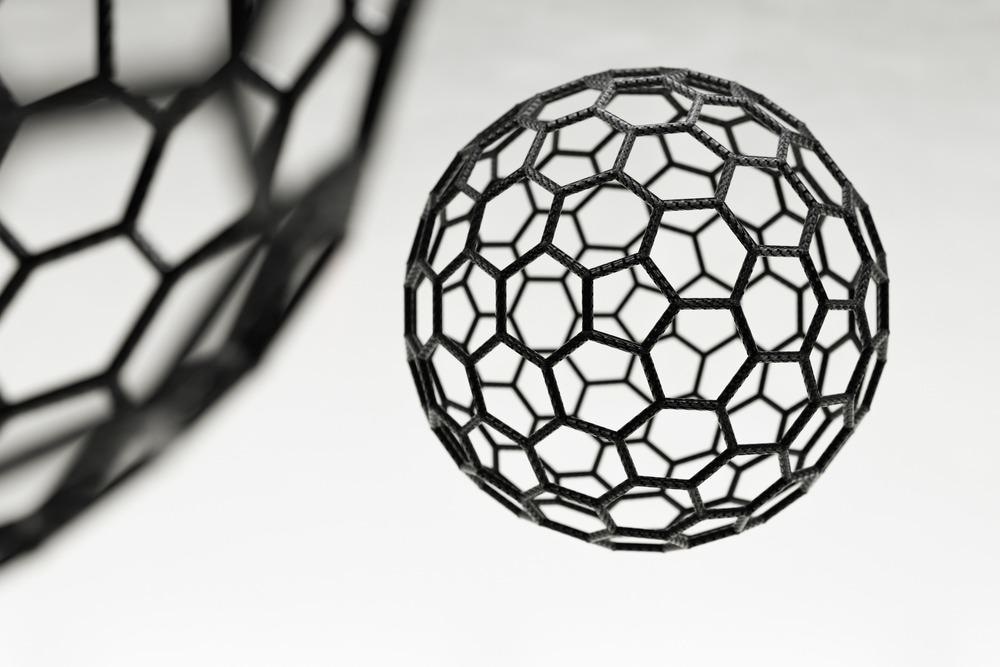Fullerene C60, being a carbon allotrope, offers numerous unique qualities that are advantageous for energy storage applications, such as accurate structure, adjustable derivatization, high solubility, and rich oxidative chemistry. This article discusses the properties, advantages, limitations, and applications of fullerenes in the energy storage industry.

Image Credit: Forance/Shutterstock.com
Fullerenes: Overview and Important Properties
A fullerene is a carbon compound whose molecule is made up of carbon atoms linked together by single and double bonds to create a closed or partly closed mesh with rings of 5 to 7 atoms. Graphene (consisting of separated atomic sheets of graphite) can be seen as an extreme member of the fullerene family.
Fullerenes have a high electron affinity and are employed in a variety of applications, including semiconductors, spectroscopy, and fuel cells. The material's structure is distinct in that its molecules are unbounded, electrically neutral, lacking borders, and contain no unpaired electrons. These properties set fullerene apart from other crystalline structures like graphite and diamond.
Fullerenes are stable but not completely inert; they may behave as electrophiles in chemical processes and are oxidizing agents that function as electron-accepting molecules.
Fullerenes exhibit remarkable superconducting properties when treated or crystallized with alkali or alkaline earth metals. A fullerene compound containing other nanomaterials, such as carbon nanotubes (CNTs), can significantly improve its distribution and catalytic properties.
Benefits of Fullerene's Properties in Energy Storage Applications
Fullerenes have received much less attention than other carbon materials for energy storage applications due to their comparatively expensive cost compared to one-dimensional carbon nanotubes (CNTs) and two-dimensional graphene. However, fullerene's multiple distinctive features hold significant promise in the realm of energy storage devices.
Fullerene has a precise structure with many unsaturated bonds that may be readily modified to yield a variety of compounds, potentially alleviating the morphological and componential variability problem that plagues many carbon materials used in rechargeable batteries.
Pristine fullerenes are extremely soluble in a wide range of organic solvents (carbon disulfide, toluene, benzene, and so forth), and their solubility in other solvents such as bicarbonate, ethanol, and aqueous solutions may be further adjusted by proper derivatization. Fullerenes also have a high electron-acceptance capacity, giving them rich redox reactivity during battery recycling.
Fullerenes in Energy Storage Applications: Recent Examples
Despite its high conductivity and strong redox activity, pure fullerene cannot be employed as an anode material in lithium-ion batteries (LIBs). As a result, additional modifications such as doping, hybridization, and chemical modification are required to achieve a high-performance, fullerene-based anode material.
Zhu et al. reacted fullerene in ammonia with an alkaline solution at different temperatures. After being activated at high temperatures, pure fullerene molecules were transformed into permeable carbon-doped molecules. As a LIB anode, this N-doped fullerene sample demonstrated high cycling stability and excellent rate efficiency in electrochemical experiments.
According to recent studies, fullerene may also serve a unique function in lithium metal batteries (LMBs). For example, Li et al. described a vacuum evaporation deposition technique for metallic lithium sheet with fullerene-magnesium composite interphase. Using the multilayer film's synergistic impact, this shielded lithium sheet reduced the formation of lithium dendrites to improve battery life and demonstrated good air stability to fulfill realistic operational needs.
Benefits and Limitations
Fullerene derivatives may receive multiple electrons, go through a swift and robust fullerene cage-based oxidation reaction, and are very inexpensive. As a consequence, fullerene is the kinetically most stable phase of molecular carbon and, with sufficient alteration, can be made very soluble in aqueous or organic solutions. As a result, it is unsurprising that they have been greatly investigated as viable options for use in energy storage devices.
In visible light and oxygen, however, fullerenes are susceptible to problems or breakdowns. Fullerenes are decomposed due to the intersystem crossover of a singlet excited state to an effectively lower triplet excited state. Many deactivation mechanisms may occur in triplet excited states, including ground-state cooling, rapid cooling by molecular oxygen, and electron transfer to atoms.
Although fullerenes' electrical capabilities make them especially appealing for electrochemical and fuel storage applications, their hydrophobic nature causes spontaneous agglomeration and limited solubility in aqueous conditions.
Future Outlook
Almost all batteries have a high-performance aim in mind. Unfortunately, most fullerene-based battery performance improvements are minimal. As a result, future studies will need a rigorous performance review for practical applications of fullerenes. Developing acceptable procedures for large-scale preparation of fullerene-based products will also benefit their practical usage.
The underlying process, including the charge transfer route, storage mechanism, and topological function, must be thoroughly investigated to create innovative fullerene-based materials for battery packs. Advanced characterization approaches may be used to investigate the mechanistic properties of fullerenes.
Theoretical simulations of energy band configurations, molecular mechanics, and reaction pathways may also assist in elucidating the operation of fullerene-based compounds for battery applications.
New battery advances made in recent years have definitely expanded the range of applications for fullerenes. Fullerene, being a unique allotrope of carbon, has numerous features yet to be identified and offers extensive application potential in the realm of energy storage applications.
References and Further Reading
Friedl, J. et al. (2018). All-Fullerene-Based Cells for Nonaqueous Redox Flow Batteries. Journal of the American Chemical Society. Available at: https://doi.org/10.1021/jacs.7b11041
Jiang, Z. et al. (2021). Fullerenes for rechargeable battery applications: Recent developments and future perspectives. Journal of Energy Chemistry, 55, 70-79. Available at: https://doi.org/10.1016/j.jechem.2020.06.065
Li, W. et al. (2020). Air-Stable and Dendrite-Free Lithium Metal Anodes Enabled by a Hybrid Interphase of C60 and Mg. Advanced Energy Materials. Available at: https://doi.org/10.1002/aenm.201903292
Zhu, Y. et al. (2017). Incorporating Pyrrolic and Pyridinic Nitrogen into a Porous Carbon made from C60 Molecules to Obtain Superior Energy Storage. Advanced Materials. Available at: https://doi.org/10.1002/adma.201603414
Disclaimer: The views expressed here are those of the author expressed in their private capacity and do not necessarily represent the views of AZoM.com Limited T/A AZoNetwork the owner and operator of this website. This disclaimer forms part of the Terms and conditions of use of this website.